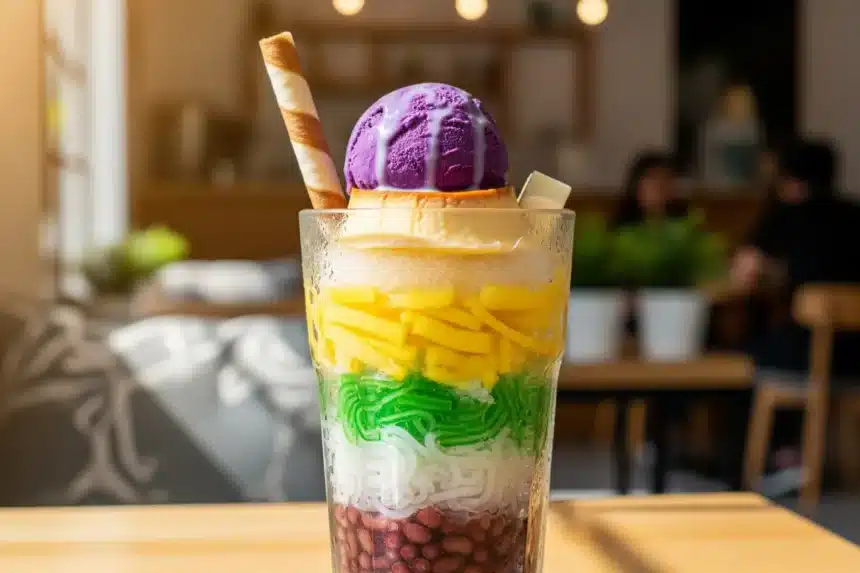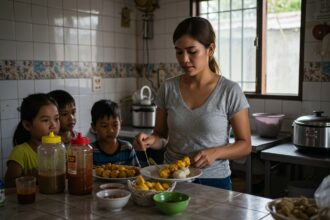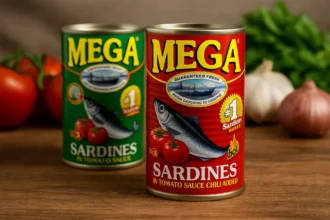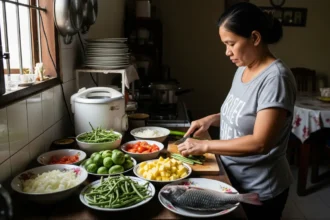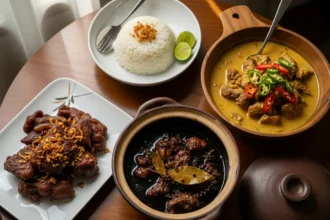Remember the sound of the magtataho echoing down the street in the early morning? Or the pure, unadulterated joy of hearing the bell of the “dirty ice cream” cart after a long, hot afternoon of playing outside? For Filipinos, desserts are more than just a sweet ending to a meal; they are woven into the very fabric of our daily lives and our fondest memories. They are the star of every handaan, the most coveted pasalubong from a traveling relative, and the simple comfort we turn to for merienda. For the longest time, these flavors felt like our own special secret, a language of love and community understood only by us.
- 🍧 1. Halo-Halo: The Undisputed King
- 💜 2. Ube Halaya: The Viral Purple Sensation
- 🍮 3. Leche Flan: The Silkiest Custard on Earth
- 🥭 4. Mango Graham Float: The No-Bake Wonder
- 🍌 5. Turon: The Ultimate Street Food Snack
- 🥥 6. Bibingka: The Taste of Filipino Christmas
- 🍰 7. Sans Rival: A Dessert “Without Rival”
- 🌴 8. Buko Pie: The Pride of Laguna
- 🌿 9. Buko Pandan: A Refreshing Medley
- 🌈 10. Sapin-Sapin: The Colorful Layered Delight
But here’s the thing about secrets this good: they never stay secret for long. Suddenly, the world is catching on. The vibrant purple of ube is flooding social media feeds, food critics are raving about the delightful chaos of Halo-Halo, and our humble turon is getting a gourmet makeover in restaurants from Dubai to New York. It’s a moment of collective Pinoy pride, watching the world fall in love with the flavors of our childhood. This isn’t just about food becoming famous; it’s about our culture, our history, and our warmth being shared and celebrated on a global stage. This is the story of the famous Filipino desserts that have broken through, the sweet ambassadors of our nation.

🍧 1. Halo-Halo: The Undisputed King
If you could capture the spirit of a Filipino fiesta in a glass, it would be Halo-Halo. The name itself, meaning “mix-mix,” is an invitation to dive in and create your own adventure. It’s a beautiful, towering masterpiece of shaved ice, evaporated milk, and a seemingly endless variety of sweet treasures hidden below. There is no single “correct” recipe, and that’s its magic. Every spoonful is a surprise-the earthy sweetness of beans, the chewy burst of nata de coco, the fragrant notes of langka, and the ultimate prize: a perfect slice of leche flan on top.
For Filipinos abroad, a single glass is a potent dose of nostalgia, a taste of a sweltering Philippine summer spent with family. For the rest of the world, it’s a dazzling introduction to the joyful and generous nature of our cuisine. It’s interactive, it’s a feast for the eyes, and it’s a complex journey of textures and flavors. Halo-Halo isn’t just a dessert; it’s an experience, and it has rightfully claimed its throne as the king of all top Pinoy desserts.
💰 A Quick Pricing Guide
- Hotels & High-End Restaurants: Expect to pay between ₱300 to ₱500+ for a gourmet version with premium ingredients.
- Casual Restaurants & Malls: Prices typically range from ₱120 to ₱280.
- Neighborhood/Street Stores: The most affordable and authentic experience can be found here, with prices from ₱50 to ₱100.
- Estimated Homemade Cost: Preparing a large batch for the whole family (good for 5-6 servings) would cost around ₱300 to ₱450, depending on the number of ingredients you include.
💜 2. Ube Halaya: The Viral Purple Sensation
Long before it was a global trend, ube was a cherished staple in the Philippines. This humble purple yam was patiently boiled, mashed, and slow-cooked with milk and butter to create Ube Halaya, a rich, dense, and creamy jam that was the heart of many other kakanin and pastries. Its flavor is wonderfully unique-a subtle blend of vanilla, pistachio, and sweet potato-that is both comforting and intriguing.
Then, social media discovered its stunning, all-natural violet hue. Suddenly, ube was everywhere. Ube ice cream, ube crinkle cookies, ube pancakes, ube cheesecake-the world went wild for purple. This global obsession, however, is rooted in the deep, authentic flavor of traditional Ube Halaya. Its incredible versatility and Instagram-worthy looks have made it a culinary superstar, proving that this once-humble root has some serious staying power on the world stage.
💰 A Quick Pricing Guide
- Hotels & High-End Restaurants: Usually not sold on its own, but featured in other desserts.
- Specialty Stores & Pasalubong Centers: A good quality tub (around 400-500g) will cost between ₱150 to ₱300.
- Neighborhood/Street Stores: Home-based sellers might offer it for ₱100 to ₱180 per tub.
- Estimated Homemade Cost: Making your own batch from fresh ube would cost approximately ₱180 to ₱280, with the main cost being the purple yam itself.
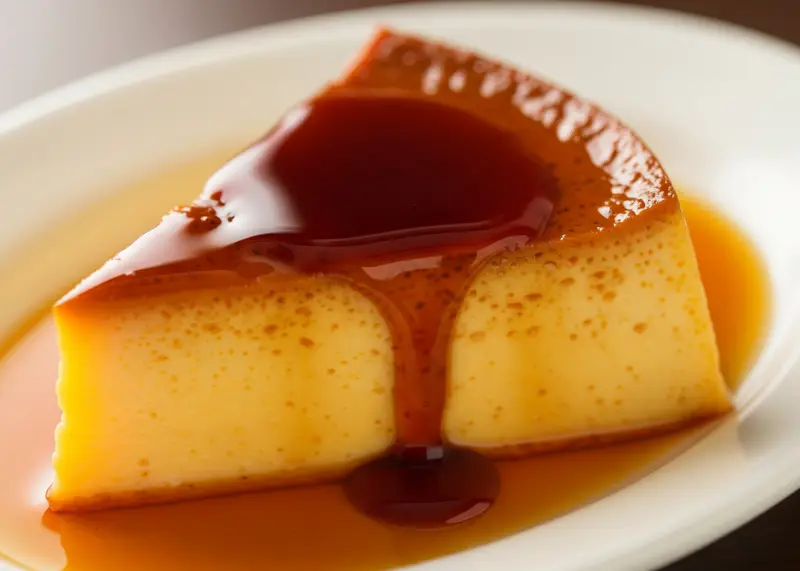
🍮 3. Leche Flan: The Silkiest Custard on Earth
Many cultures have a version of caramel custard, but the Filipino Leche Flan is, without exaggeration, a transcendent experience. What sets our version apart is its unapologetic richness. We use a generous amount of egg yolks and condensed milk, resulting in a flan that is significantly denser, creamier, and more velvety than its international cousins.
Steamed gently in a tin mold called a llanera, the custard achieves an impossibly smooth texture that melts in your mouth. The dark, slightly bitter caramel syrup provides the perfect contrast to the sweet, creamy body of the flan. It’s a dessert of elegant simplicity and pure indulgence, serving as the perfect “gateway” for those new to Filipino sweets and a constant source of pride for every Pinoy home cook who has perfected their family’s recipe.
💰 A Quick Pricing Guide
- Hotels & High-End Restaurants: A single, elegant slice can range from ₱150 to ₱280.
- Casual Restaurants & Bakeshops: A whole llanera typically costs between ₱200 to ₱400.
- Neighborhood/Street Stores: You can find smaller, home-style llaneras for ₱70 to ₱150.
- Estimated Homemade Cost: A standard-sized llanera is quite economical to make at home, costing around ₱180 to ₱250.
🥭 4. Mango Graham Float: The No-Bake Wonder
When you have access to the sweetest mangoes in the world, you don’t need to do much to make them shine. The Mango Graham Float is a testament to this philosophy. It’s a brilliantly simple yet incredibly delicious icebox cake that has become a modern classic at Filipino celebrations. All it takes are three key components: layers of graham crackers, a luscious cream mixture of condensed milk and all-purpose cream, and, of course, slices of ripe, fragrant Philippine mangoes.
After a few hours in the refrigerator, a bit of magic happens. The graham crackers soften to a perfect cake-like consistency, absorbing the sweet cream and melding with the bright, tropical flavor of the mangoes. Its popularity abroad is fueled by its sheer accessibility-anyone can make it, anywhere. It’s a refreshing, crowd-pleasing dessert that delivers a taste of a Philippine tropical paradise in every single bite.
Barangay Story: It’s Saturday afternoon, and there’s a potluck at the community hall. Tita Josie walks in carrying her signature rectangular glass dish, and everyone knows what’s inside. Her Mango Graham Float is legendary. The kids immediately abandon their games, and even the uncles playing mahjong pause for a slice. It’s more than just a dessert; it’s a symbol of community, of sharing, and of the simple, sweet moments that bring everyone together.
💰 A Quick Pricing Guide
- Hotels & High-End Restaurants: A fancy slice can cost between ₱200 to ₱350.
- Casual Restaurants & Cafes: A slice is usually ₱120 to ₱180, while a whole tray can be ₱600 to ₱900.
- Neighborhood/Street Stores: Home-based sellers offer personal-sized tubs for ₱80 to ₱150.
- Estimated Homemade Cost: A family-sized tray is very cost-effective, with ingredients totaling around ₱350 to ₱500, depending on the price of mangoes.

🍌 5. Turon: The Ultimate Street Food Snack
Simple, crunchy, and deeply satisfying, Turon is the undisputed king of Filipino street food snacks. It’s a brilliant invention: a slice of sweet saba banana, often paired with a sliver of jackfruit, is rolled in brown sugar, wrapped tightly in a spring roll wrapper, and fried to a glorious golden crisp. That final step is crucial, as the sugar on the outside caramelizes into a brittle, glass-like coating that shatters delightfully with each bite.
Its global appeal lies in its straightforward deliciousness. It’s a sweet, comforting, and texturally perfect handheld treat. You don’t need to be familiar with Filipino cuisine to immediately fall in love with it. Now, you can find it on the menus of Filipino restaurants worldwide, sometimes served elegantly with a scoop of coconut or vanilla ice cream, proving that the simplest Filipino desserts loved globally can often make the biggest impact.
💰 A Quick Pricing Guide
- Hotels & High-End Restaurants: A “deconstructed” or gourmet version with ice cream can cost ₱180 to ₱300.
- Casual Restaurants & Malls: Often sold as a pair for ₱60 to ₱120.
- Neighborhood/Street Stores: This is where Turon shines. Expect to pay only ₱12 to ₱25 per piece.
- Estimated Homemade Cost: This is one of the cheapest desserts to make. A dozen pieces can be made for as little as ₱100 to ₱150.
🥥 6. Bibingka: The Taste of Filipino Christmas
For many Filipinos, the Christmas season officially begins with the first scent of Bibingka being cooked in the early morning air, right after Simbang Gabi. This traditional rice cake is more than just food; it’s an experience. Made from galapong (milled glutinous rice) and coconut milk, it’s traditionally cooked in a clay pot lined with banana leaves, with hot coals placed both underneath and on top. This unique cooking method gives it a wonderfully soft, slightly spongy texture and a distinct smoky aroma.
Topped with slices of salted duck egg and kesong puti (white cheese), and finished with a generous spread of butter and a sprinkle of fresh grated coconut, Bibingka is a masterful blend of sweet, savory, and smoky. It’s a complex and comforting flavor profile that is now captivating food lovers around the world, offering them a true taste of a Filipino Christmas.
💰 A Quick Pricing Guide
- Hotels & High-End Restaurants: Premium Bibingka, often with deluxe toppings, can cost ₱250 to ₱500.
- Casual Restaurants & Malls: A good-sized Bibingka usually costs between ₱150 to ₱250.
- Neighborhood/Street Stores (especially during Christmas): The classic street-side experience will cost you ₱50 to ₱120 per piece.
- Estimated Homemade Cost: Making a batch at home to yield 2-3 medium-sized bibingkas would cost around ₱250 to ₱350.
🍰 7. Sans Rival: A Dessert “Without Rival”
True to its French name, Sans Rival is a dessert that is truly “without rival.” This luxurious and sophisticated cake is a masterpiece of texture and flavor. It features layers of crisp, chewy meringue wafers made with ground cashews, sandwiched together by a sinfully rich and buttery French buttercream. The entire cake is then covered in more buttercream and generously coated with chopped, toasted cashews.
The experience of eating Sans Rival is a spectacular journey. You get the crunch from the nuts, the crisp-then-chewy texture of the meringue, and the smooth, decadent creaminess of the buttercream all in one bite. While it’s one of the more challenging Filipino desserts to master, its reputation as a world-class confection is well-deserved and continues to grow among international dessert aficionados.
💰 A Quick Pricing Guide
- Hotels & High-End Restaurants: A single slice can be quite pricey, ranging from ₱250 to ₱400.
- Specialty Bakeshops: A whole cake is a premium item, costing anywhere from ₱900 to ₱1,800. A slice would be ₱150 to ₱250.
- Neighborhood/Street Stores: Not typically available.
- Estimated Homemade Cost: Due to the high cost of butter and cashews, this is an expensive cake to make at home, with ingredients for one cake costing ₱700 to ₱1,000.
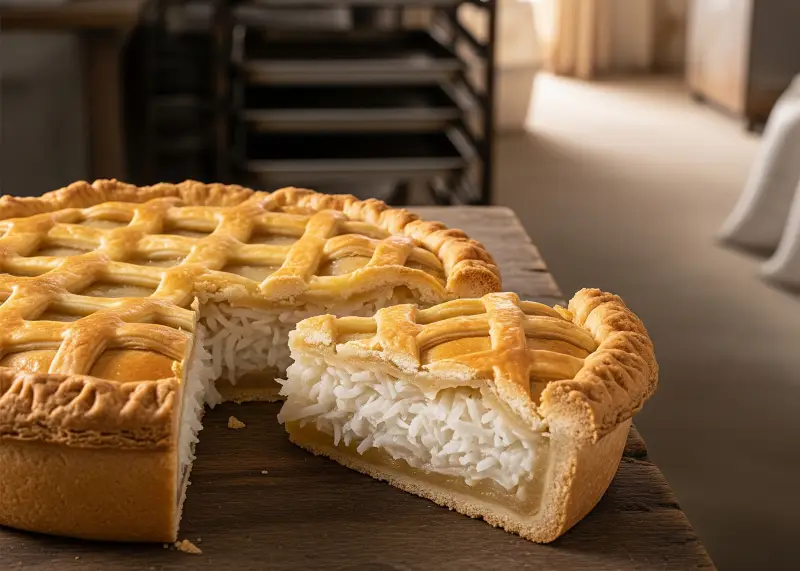
🌴 8. Buko Pie: The Pride of Laguna
A road trip heading south from Manila isn’t complete without the obligatory stop for Buko Pie. This isn’t the overly sweet, artificially flavored coconut cream pie you might find elsewhere. The authentic Filipino Buko Pie is a celebration of the young coconut, or buko. The filling is packed with tender, delicate strips of fresh coconut meat, suspended in a light, creamy custard that allows the clean, natural flavor of the buko to be the star.
All of this goodness is encased in a simple, flaky pastry crust that provides the perfect buttery foundation. Its charm is its rustic honesty and its focus on a single, perfect ingredient. Travelers who have tasted the real deal in the Philippines often spend years trying to replicate the experience, helping to spread the legend of this beloved pasalubong.
💰 A Quick Pricing Guide
- Hotels & High-End Restaurants: A warm slice with cream or ice cream might cost ₱180 to ₱300.
- Casual Restaurants: A slice is typically priced between ₱80 to ₱150.
- Specialty Roadside Stalls (Pasalubong Centers): A whole, freshly baked pie costs between ₱250 to ₱400.
- Estimated Homemade Cost: Making a whole pie from scratch would cost around ₱220 to ₱320.
🌿 9. Buko Pandan: A Refreshing Medley
Another dessert that celebrates the beloved buko is the ever-popular Buko Pandan. This creamy, fragrant, and refreshingly cool dessert is a non-negotiable staple at any Filipino party, fiesta, or Noche Buena spread. It’s a simple but brilliant concoction of young coconut strips, green gelatin cubes (gulaman) infused with the beautifully aromatic flavor of pandan leaves, and sometimes sago pearls.
Everything is mixed in a sweet, creamy sauce made from all-purpose cream and condensed milk. The resulting flavor is light, fragrant, and unmistakably Southeast Asian. It’s incredibly easy to make, which has made it a go-to potluck contribution for Filipinos living abroad, introducing countless new fans to its unique and delightful taste.
💰 A Quick Pricing Guide
- Hotels & High-End Restaurants: A serving in a fancy glass can be ₱150 to ₱250.
- Casual Restaurants: A single serving cup costs around ₱80 to ₱130.
- Home-based Sellers: Party trays are popular and can range from ₱500 to ₱800 depending on the size.
- Estimated Homemade Cost: A large batch perfect for a party is economical, with ingredients costing between ₱300 to ₱450.
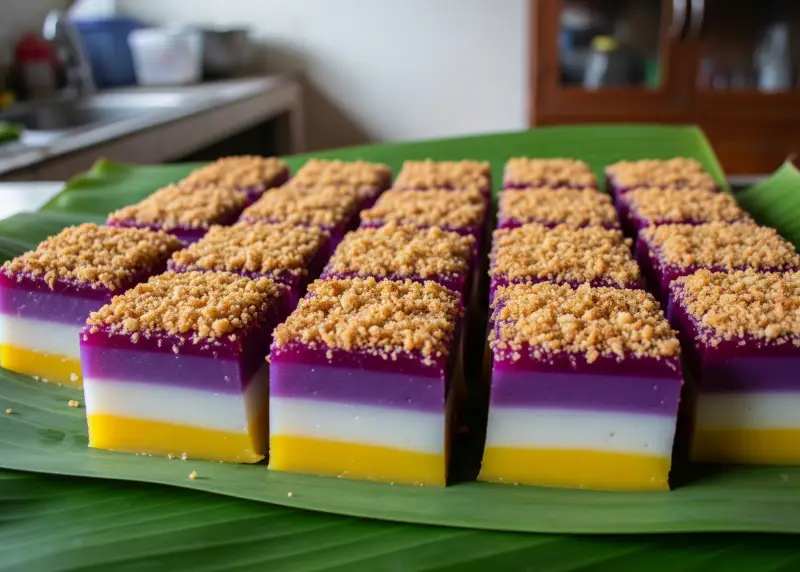
🌈 10. Sapin-Sapin: The Colorful Layered Delight
Sapin-Sapin, which literally translates to “layers,” is a perfect example of how Filipino desserts can be both delicious and a work of art. This steamed glutinous rice cake, or kakanin, is instantly recognizable for its vibrant, distinct layers. Traditionally, the colors represent different flavors: purple for ube, yellow or orange for jackfruit, and white for a simple, pure coconut flavor.
Made from glutinous rice flour, coconut milk, and sugar, each layer is cooked individually before being combined, resulting in a wonderfully sticky, chewy, and fragrant dessert. It’s typically finished with a sprinkle of latik (toasted coconut milk curds), which adds a nutty flavor and a delightful crunchy contrast. Its unique look and satisfying texture make it a memorable treat that showcases the playful and creative spirit of our cuisine.
💰 A Quick Pricing Guide
- Hotels & High-End Restaurants: Rarely sold, but may appear on a Filipino-themed dessert buffet.
- Casual Restaurants: A small plate with a few slices might cost ₱60 to ₱100.
- Neighborhood/Street Stores & Markets: This is the best place to buy it. A slice costs ₱15 to ₱30, while a whole bilao (tray) can range from ₱250 to ₱450.
- Estimated Homemade Cost: Very affordable to make. A whole llanera or small tray would cost around ₱150 to ₱250 in ingredients.
📌 Frequently Asked Questions
1. What is the most famous dessert in the Philippines? Hands down, Halo-Halo is considered the most famous and iconic Filipino dessert. Its unique combination of ingredients and interactive “mix-mix” nature make it a beloved national treasure.
2. What does “kakanin” mean? Kakanin refers to a broad category of native Filipino delicacies made from glutinous rice (malagkit) and coconut milk. The term comes from the word “kanin,” meaning rice. Bibingka, Sapin-Sapin, and Biko are all popular types of kakanin.
3. Why is ube suddenly so popular worldwide? Ube’s global popularity is driven by its stunning natural purple color, which is perfect for social media platforms like Instagram. Beyond its looks, it has a unique, delicious flavor that is versatile enough for everything from ice cream to bread.
4. Are Filipino desserts generally very sweet? Yes, many traditional Filipino desserts have a pronounced sweetness, largely due to the common use of ingredients like condensed milk and brown sugar. However, this sweetness is often balanced by other flavors like the saltiness in Bibingka’s salted egg or the fresh fruit in Mango Float.
5. What is a good “starter” dessert for someone new to Filipino food? Leche Flan or Turon are excellent choices for beginners. Leche Flan is a richer version of the universally loved crème caramel, while Turon’s simple combination of banana and a crispy wrapper is instantly appealing and easy to enjoy.
6. Where can I find these desserts outside the Philippines? You can often find them in Filipino restaurants, bakeries, and Asian supermarkets in cities with significant Filipino populations. Additionally, many recipes are available online, and ingredients like ube halaya and frozen grated cassava can be purchased in specialty stores.
7. Is there a big difference between Filipino Leche Flan and Spanish Crème Caramel? Yes. The main difference is in the ingredients. Filipino Leche Flan uses a higher ratio of egg yolks and condensed milk, making it much richer, denser, and creamier than its Spanish counterpart, which typically uses whole eggs and fresh milk.
8. What drinks pair well with these desserts? A hot cup of strong Filipino coffee (kapeng barako) pairs wonderfully with kakanin like Bibingka. For richer desserts like Sans Rival or Leche Flan, a simple black tea can cut through the sweetness. For refreshing treats like Halo-Halo, no drink is needed!
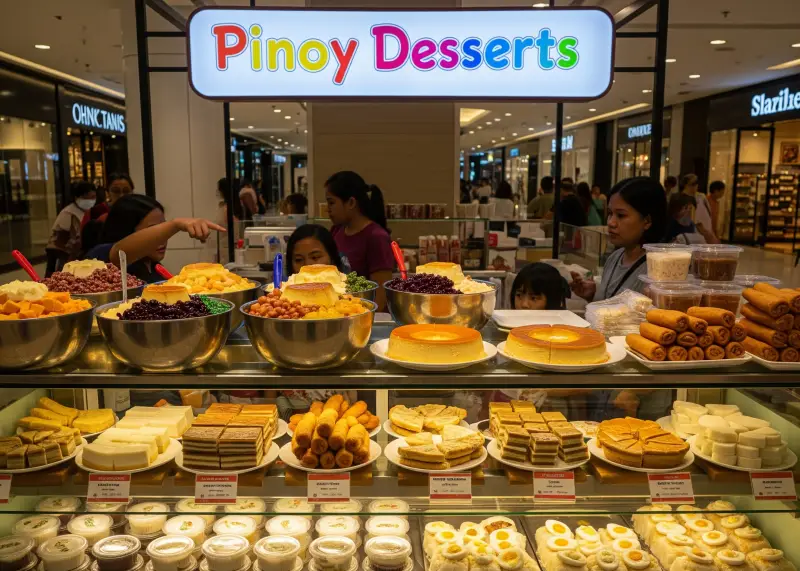
Our Sweetest Ambassadors
From a humble street-side cart in Manila to a high-end dessert bar in Los Angeles, the journey of these Pinoy desserts is nothing short of remarkable. They are more than just sweet panghimagas; they are edible stories, each bite a taste of our history, our ingenuity, and our deep-seated love for gathering and celebration. Seeing a dessert like Ube Halaya go from a simple fiesta staple to a worldwide phenomenon is a powerful reminder of the richness of our culinary heritage.
It proves that the flavors we hold dear have a universal language, capable of bringing joy to anyone, anywhere. As the world continues to wake up to the magic of Filipino food, one thing is certain: our desserts are leading the charge, acting as the sweetest, most colorful ambassadors for our culture. So, the next time you share a slice of Buko Pie with a friend, you’re sharing more than just a treat-you’re sharing a piece of home.



